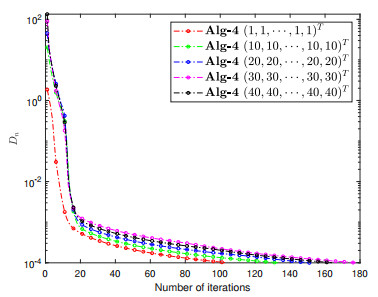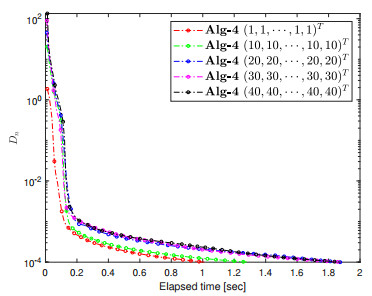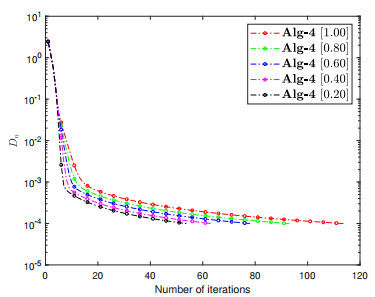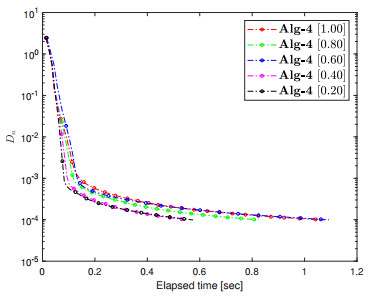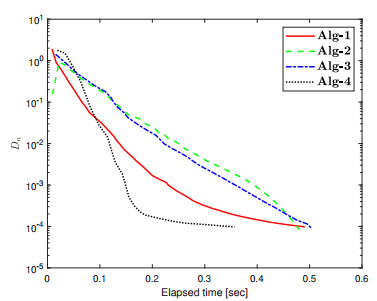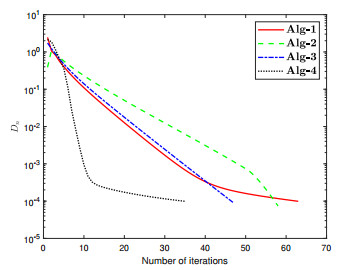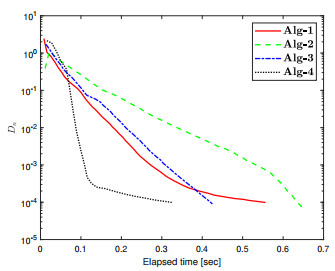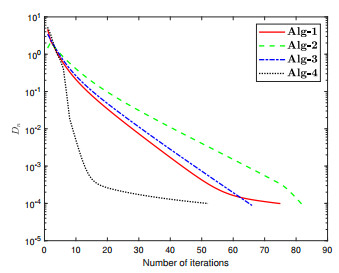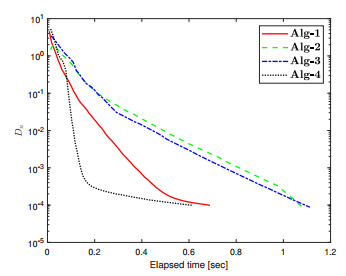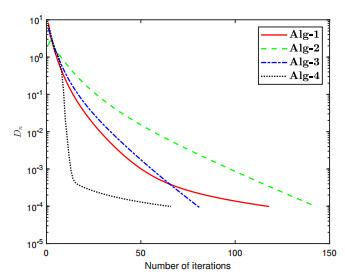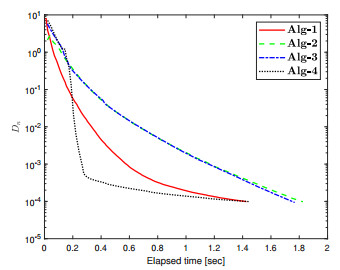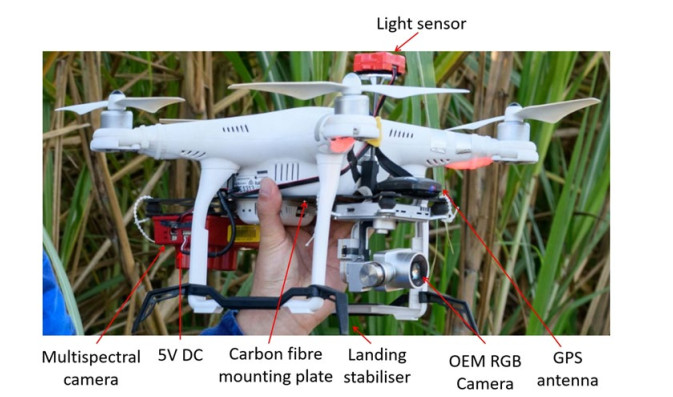1.
Introduction
Assume that D is a nonempty, closed and convex subset of a real Hilbert space E. Let f:E×E→R be a bifunction with f(v,v)=0 for all v∈D. An equilibrium problem (shortly, EP) for f on D is defined in the following manner: Find ζ∗∈D such that
Moreover, the solution set of an equilibrium is denoted by SEP. In this study, the problem (EP) is studied based on the following conditions. A bifunction f:E×E→R is said to be (see for more details [3,4]):
(C1) pseudomonotone on D if
(C2) Lipschitz-type continuous [15] on D if there exists two constants k1,k2>0 such that
(C3) For any weakly convergent sequence {vn}⊂D (vn⇀v∗) the following inequality holds
(C4) f(v,⋅) is convex and subdifferentiable on E for each fixed v∈E.
The general format of the problem (EP) has become attractive and has received a lot of attention from several authors in recent years. Mathematically, the problem (EP) can be considered as a generalization of many mathematical models, such as the fixed-point problems, scalar and vector minimization problems, the complementarity problems, the variational inequalities problems, the Nash equilibrium problems in non-cooperative games, the saddle point problems and the inverse minimization problems [4,12,17]. The equilibrium problem (EP) has applications in economics [8] or the dynamics of offer and demand [1], continuing to exploit the theoretical structure of non-cooperative games and the Nash equilibrium idea [18,19]. To the best of our knowledge, the term "equilibrium problem" was first used in the literature in 1992 by Muu and Oettli [17] and was later studied further by Blum and Oettli [4].
By using the idea of the Korpelevich extragradient method [13], Flam et al. [10] and Quoc et al. [21] introduced the following method for solving equilibrium problems involving pseudomonotone and Lipschitz-type bifunction. Choose a random starting point of u0∈D; looking the given iteration un and choose the next iteration using the iterative scheme:
where 0<ρ<min{12k1,12k2} and k1,k2 are two Lipschitz-type constants of a bifunction (1.2). The method (1.4) has been extended and modified in various ways [16,24,25,26,27,29] and others in [2,6,22,30,32,34,35,36].
It deserves mention that the above well-established method carries two significant drawbacks. The first is the constant stepsize that requires the knowledge or approximation of the Lipschitz constant of the relevant bifunction and it only converges weakly in Hilbert spaces. From the computational point of view, it might be hard to use a fixed stepsize, and hence, the convergence rate and usefulness of the method could be influenced. The inertial-type algorithms are of particular interest here. These algorithms are derived from an oscillator equation with damping and a conservative restoring force. This second-order dynamical system is known as Heavy Ball with Friction, and it was first studied by Polyak [20]. In general, the main feature of the inertial-type algorithms is that we can use the two previous iterations to construct the next one. Recently, inertial-type algorithms have been widely studied for the special cases of the problem (EP).
A natural question therefore arises:
Is it possible to introduce a new inertial strongly convergent extragradient method with a non-monotone stepsize rule to determine the numerical solution of the problem (EP) involves a pseudomonotone bifunction?
In this study, we provide a positive answer to this question, i.e., the gradient method still operate in the case of a non-monotonic stepsize rule for solving equilibrium problems accompanied by a pseudomonotone bifunction and obtain a strong convergence of the iterative sequence. We introduce a new extragradient-type method to solve the problem (EP) in the context of an infinite-dimensional real Hilbert space, inspired by the works of [7,20,21]. The key contributions to this research are given below:
(∙) We introduce a new self-adaptive subgradient extragradient method by using an inertial scheme and a non-monotone stepsize rule to solve equilibrium problems. Also, we confirm that the generated sequence is strongly convergent. This result can be regarded as a modification of the method (1.4).
(∙) The applications of our main results are considered in order to solve particular classes of equilibrium problems in a real Hilbert space.
(∙) The numerical experiments regarding Algorithm 1 with Algorithm 3.1 in [11], Algorithm 1 in [28] and Algorithm 3 in [31]. The numerical results have indicated that the suggested method is appropriate and performed better compared to the existing ones.
The rest of the study has been arranged as follows: Section 2 includes basic definitions and key lemmas that are used throughout this manuscript. Section 3 consists of the proposed iterative scheme with a variable stepsize rule and a theorem of convergence analysis. Section 4 sets out the application of the proposed results to solve the problems of variational inequalities and fixed point problems. Section 5 gives numerical results to illustrate the performance of the new algorithms and equate them with the two existing algorithms.
2.
Preliminaries
Let D be a nonempty, closed and convex subset of a real Hilbert space E. The metric projection PD(u) of u∈E onto a closed and convex subset D of E is defined by
Definition 2.1. Let D be a subset of a real Hilbert space E and ϰ:D→R a given convex function.
(1). The subdifferential of set ϰ at u∈D is defined by
(2). The normal cone at u∈D is defined by
Lemma 2.2. [23] Assume that ϰ:D→R is a convex, subdifferentiable and lower semicontinuous function on D. An element u∈D is a minimizer of a function ϰ if and only if
where ∂ϰ(u) stands for the subdifferential of ϰ at u∈D and ND(u) the normal cone of D at u.
Lemma 2.3. [33] Assume that {an}⊂(0,+∞) is a sequence satisfying the following inequality
Moreover, {bn}⊂(0,1) and {cn}⊂R are sequences such that
Then, limn→∞an=0.
Lemma 2.4. [14] Assume that {an}⊂R is a sequence and there exists a subsequence {ni} of {n} such that ani<ani+1 for all i∈N. Then, there exists a nondecreasing sequence mk⊂N such that mk→∞ as k→∞, and the subsequent conditions are fulfilled by all (sufficiently large) numbers k∈N:
Indeed, mk=max{j≤k:aj≤aj+1}.
3.
Main algorithm and its convergence analysis
Now, we introduce a new variant of Algorithm (1.4) in which the constant stepsize ρ is chosen adaptively.
Remark 3.1. By the use of ρn+1 in expression (3.2), we obtain
Lemma 3.1. Suppose that the conditions (C1)–(C4) are satisfied and {un} be a sequence generated by Algorithm 1. Then, we have
Proof. By the use of definition of un+1, we obtain
Thus, there exists ωn∈∂2f(vn,un+1) and ¯ωn∈ND(un+1) such that
The above expression implies that
Due to ¯ωn∈ND(un+1) imply that ⟨¯ωn,v−un+1⟩≤0, for every v∈D. Thus, we obtain
By given ωn∈∂2f(vn,un+1), we have
From expressions (3.5) and (3.6), we obtain
In the similar way, vn gives that
By the use of v=un+1 into expression (3.8), we get
By the use of v=ζ∗ into expression (3.7), we obtain
Since ζ∗∈SEP implies that f(ζ∗,vn)≥0 and pseudomonotonicity of a bifunction f gives that f(vn,ζ∗)≤0. Thus, expression (3.10) implies that
From expression (3.2), we have
Combining expressions (3.11) and (3.12) gives that
From expressions (3.9) and (3.13), we obtain
By the use of following formulas:
Finally, we have
Theorem 3.2. Assume that conditions (C1)–(C4) are satisfied. Then, the sequence {un} generated by Algorithm 1 converges strongly to an element ζ∗=PSEP(0).
Proof. Thus, expression (3.1) implies that
By the use of definition of {χn} and inequality (3.16), we obtain
where
By the use of Lemma 3.1, we obtain
Combining (3.18) with (3.19), we obtain
Thus, we infer that the sequence {un} is bounded. Indeed, by (3.18) we have
for some K2>0. Combining the expressions (3.4) with (3.21), we have
Due to the Lipschitz-continuity and pseudomonotonicity of f implies that the solution set SEP is a closed and convex set (for further details see [21]). It is given that ζ∗=PSEP(0) such that
The remainder of the proof is divided into the following two cases:
Case 1: Assume that there exists a fixed number N1∈N such that
Thus, above expression implies that limn→+∞‖un−ζ∗‖ exists and let limn→+∞‖un−ζ∗‖=l, for some l≥0. From the expression (3.22), we have
Due to existence of limit of the sequence ‖un−ζ∗‖ and ψn→0, we conclude that
It continues from (3.25) that
Next, we have to compute
The above expression implies that
he above explanation guarantees that the sequences {χn} and {vn} are also bounded. Due to the reflexivity of E and the boundedness of {un} guarantees that there exists a subsequence {unk} such that {unk}⇀ˆu∈E as k→+∞. Next, we have to prove that ˆu∈SEP. Due to the inequality (3.7) we have
where v is an arbitrary element in En. It continues from that (3.26)–(3.29) and the boundedness of {un} that the right-hand side goes to zero. From ρn>0, the condition (1.3) and vnk⇀ˆu, we have
It implies that f(ˆu,v)≥0,∀v∈D, and hence ˆu∈SEP. Next, we have
By the use of limn→+∞‖un+1−un‖=0. Thus, expression (3.32) implies that
By the use of expression (3.17), we have
From expressions (3.19) and (3.34) we obtain
By the use of (3.27), (3.33), (3.35) and applying Lemma 2.3, conclude that limn→+∞‖un−ζ∗‖=0.
Case 2: Suppose that there exists a subsequence {ni} of {n} such that
By using Lemma 2.4 there exists a sequence {mk}⊂N as {mk}→+∞ such that
As similar to Case 1, the expression (3.25) implies that
Due to ψmk→0, we deduce the following:
It follows that
Next, we have to evaluate
It follows that
By using the same explanation as in the Case 1, such that
By using the expressions (3.35) and (3.36), we obtain
Thus, above expression implies that
Since ψmk→0, and ‖umk−ζ∗‖ is a bounded sequence. Therefore, expressions (3.42) and (3.44) implies that
It implies that
As a consequence un→ζ∗. This completes the proof of the theorem.
4.
Applications
In this section, we have written about the new results from our main proposed methods to solve variational inequalities. In the last few years, variational inequalities have drawn a considerable amount of attention from both researchers and readers. It is well established that variational inequalities deal with a large variety of topics in partial differential equations, optimal control, optimization techniques, applied mathematics, engineering, finance, and operational science. The variational inequality problem for an operator A:E→E is defined as follows:
We consider the following conditions to study the variational inequalities.
(A1) The solution set of the problem (VIP) is denoted by VI(A,D) and it is nonempty;
(A2) An operator A:E→E is said to be a pseudomonotone if
(A3) An operator A:E→E is said to be a Lipschitz continuous if there exists a constants L>0 such that
(A4) An operator A:E→E is said to be sequentially weakly continuous, i.e., {A(un)} weakly converges to A(u) for every sequence {un} converges weakly to u.
On the other hand, we have also developed some results to solve fixed point problems. The existence of a solution to a theoretical or real-world problem should be analogous to the existence of a fixed point for an appropriate map or operator. Fixed-point theorems are thus extremely important in many fields of mathematics, engineering, and science. In many cases, it is not difficult to find an exact solution. Therefore, it is crucial to create effective techniques to approximate the desired result. The fixed point problem for an operator B:E→E is defined as follows:
The following conditions are required to study fixed point theorems.
(B1) The solution set of the problem (FPP) is denoted by Fix(B,D) is nonempty;
(B2) B:D→D is said to be a κ-strict pseudocontraction [5] on D if
(B3) B:E→E is said to be weakly sequentially continuous, i.e., {B(un)} weakly converges to B(u) for every sequence {un} converges weakly to u.
Corollary 4.1. Assume that an operator A:D→E satisfies the conditions (A)–(A) and the solution set VI(A,D)≠∅. Choose u0,u1∈D, ϕ>0, 0<σ<min{1,1L},μ∈(0,1), ρ1>0. Moreover, select {ψn}⊂(0,1) meet the conditions, i.e.,
(i) Compute
where ϕn modified on each iteration as follows:
where ϵn=∘(ψn) is a positive sequence such that limn→+∞ϵnψn=0.
(ii) Compute
where
(iii) Compute
Then, the sequences {un} converge strongly to ζ∗∈VI(A,D).
Corollary 4.2. Assume that B:D→D is a κ-strict pseudocontraction and weakly continuous with solution set Fix(B,D)≠∅. Choose u0,u1∈D, ϕ>0, 0<σ<min{1,1−κ3−2κ},μ∈(0,1), ρ1>0. Moreover, select {ψn}⊂(0,1) meet the conditions, i.e.,
(i) Compute
where ϕn modified one each iteration as follows:
where ϵn=∘(ψn) is a positive sequence such that limn→+∞ϵnψn=0.
(ii) Compute
where
(iii) Evaluate stepsize rule for next iteration is evaluated as follows:
Then, the sequence {un} converges strongly to ζ∗∈Fix(B,D).
5.
Numerical illustrations
In this section, the numerical performance of the proposed method is described in contrast with some similar works in the literature.
Example 5.1. The test problem here taken from the Nash-Cournot Oligo-polistic equilibrium model in [9,21]. Suppose that the set D is defined by
and f:D×D→R is defined as follows
where r∈RN and M, N matrices of order N. The matrix M is symmetric positive semi-definite and the matrix N−M is symmetric negative semi-definite with Lipschitz-type criteria k1=k2=12‖M−N‖ (see [21] for details). Two matrices M,N are taken randomly [Two diagonal matrices randomly A1 and A2 with elements from [0,2] and [−2,0], respectively. Two random orthogonal matrices O1=RandOrthMat(N) and O2=RandOrthMat(N) are generated. Thus, a positive semi-definite matrix B1=O1A1OT1 and a negative semi-definite matrix B2=O2A2OT2 is obtained. Finally, set N=B1+BT1,S=B2+BT2 and M=N−S].
Experiment 1: In the first experiment, we take into account the numerical efficiency of the Algorithm 1 using different starting point choices. This experiment helps the reader see how much the starting points influenced the efficiency of the Algorithm 1. For these numerical results, we have use N=20, u0=u1, ρ1=0.50,σ=12.2k1,μ=0.22,ϕ=1.00,ϵn=1(n+1)2,ψn=120(n+2),Dn=Error=‖un+1−un‖ for Algorithm 1 (Alg-4). Figures 1 and 2 demonstrate the numerical efficacy of the proposed mehod.
Experiment 2: In the second experiment, we consider the numerical efficiency of the Algorithm 1 using different inertial parameter ϕ choices. This experiment helps the reader see how much the inertial parameter ϕ influenced the efficiency of the Algorithm 1. For these numerical results, we have use N=20, u0=u1=(1,1,⋯,1,1), ρ1=0.30,σ=12.5k1,μ=0.33,ϵn=1(n+1)2,ψn=110(n+2),Dn=Error=‖un+1−un‖ for Algorithm 1 (Alg-4). Figures 3 and 4 demonstrate the numerical efficacy of the proposed method.
Experiment 3: In third experiment, we provide the numerical comparison of Algorithm 1 with Algorithm 1 in [28] and Algorithm 3.1 in [11] and Algorithm 3 in [31]. For these numerical studies we have assumed that starting points are u0=u1=v0=(1,1,⋯,1), N=5,10,40,100 and error term Dn=‖un+1−un‖. Figures 5–12 have shown a number of results for Tolerance = 10−4. Information regarding the control parameters shall be considered as described in the following:
(i)ρn=14k1,ϕn=1(n+1)0.5, and Error=‖un+1−un‖ for Algorithm 3.1 in [11] (Alg-1).
(ii)ρ=14k1,θ=0.50, ϵn=1(n+1)2,γn=120(n+2),βn=710(1−γn),Error=‖un+1−un‖ for Algorithm 3 in [31] (Alg-2).
(iii)ρ=15k1, ϕn=1100(n+2), f(u)=u2 and Error=‖un+1−un‖ for Algorithm 1 (Alg-3) in [28].
(iv)ρ1=0.50,σ=12.2k1,μ=0.22,ϕ=1.00,ϵn=1(n+1)2,ψn=120(n+2),Error=‖un+1−un‖ for Algorithm 1 (Alg-4).
Then numerical results are reported in Table 1.
6.
Conclusions
We constructed an explicit, inertial extragradient-type method to find a numerical solution to the pseudomonotone equilibrium problems in a real Hilbert space. This method is seen as a modification of the two-step gradient method. A strongly convergent result is well-proven, corresponding to the proposed algorithm. Numerical findings were presented to demonstrate our algorithm's numerical superiority over existing methods. These computational findings have indicated that the variable stepsize rule continues to increase the performance of the iterative sequence in this context.
Acknowledgments
Pongsakorn Yotkaew was financial support by Khon Kaen University. Nuttapol Pakkaranang would like to thank Phetchabun Rajabhat University.
Conflict of interest
No potential conflict of interest was reported by the authors.









 DownLoad:
DownLoad:
